G.Skill Trident Z DDR4-3200, C14, 32GB, Quad-Channel Kit Review
Why you can trust Tom's Hardware
Test Results And Final Analysis
We love to lead a page with a photo, but we’ve already shown the appearance of G.Skill’s black-and-white Trident Z. Yet we did create one more image that will help start a conversation:
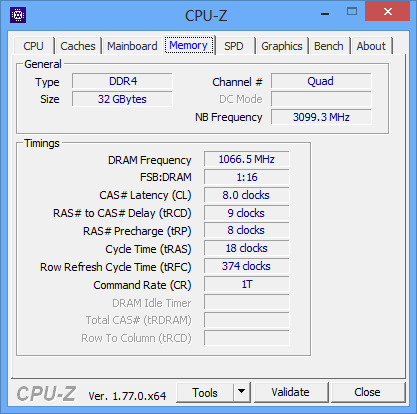
Bandwidth fanatics will scream “Why did you lead with your lowest test setting,” but latency fiends will see the point: Because cycle time is the inverse of frequency, DDR4-2133 CAS 8 has the same real-time latency as DDR3-1600 CAS 6. What this means is that in at least one configuration, DDR4 has finally caught up to the best latency performance that DDR3 could offer.
Lowest Stable Timings at 1.35V (Max) on Asus Rampage V Extreme (BIOS 3301):
| Header Cell - Column 0 | G.Skill Trident Z 32GB F4-3200C14Q-32GTZKW | G.Skill Ripjaws V 16GB F4-3600C17Q-16GVK | Corsair Vengeance LPX CMK16GX4M4B3200C16 |
|---|---|---|---|
| DDR4-3200 | 14-14-14-28 (1T) | 15-16-16-32 (1T) | 16-16-16-32 (1T) |
| DDR4-2666 | 11-11-11-22 (1T) | 13-14-14-28 (1T) | 14-14-14-28 (1T) |
| DDR4-2133 | 8-9-8-18 (1T) | 11-11-11-22 (1T) | 11-11-11-22 (1T) |
The new Trident Z’s latency tweaking advantage persists at DDR4-2666, but decreases at its rated DDR4-3200. We weren’t able to drop even one of the three main timings a mere cycle below its rated DDR4-3200 values, though tRAS was a little more flexible.
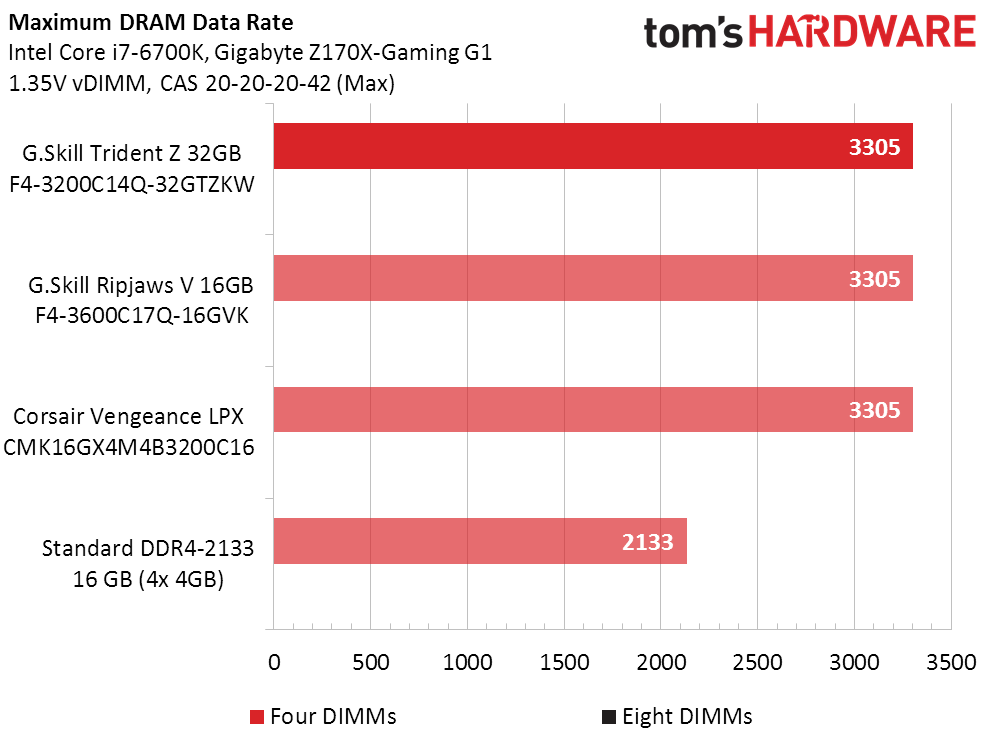
No viable settings would allow this CPU to stably support any of our memory samples at data rates higher than 3305 MHz. Extra-high System Agent voltage initially showed promise for reaching at least DDR4-3466, but only after also increasing CPU core voltage to thermally-unsustainable levels. In other words, the voltage settings required to clock the memory higher only worked until the CPU overheated.
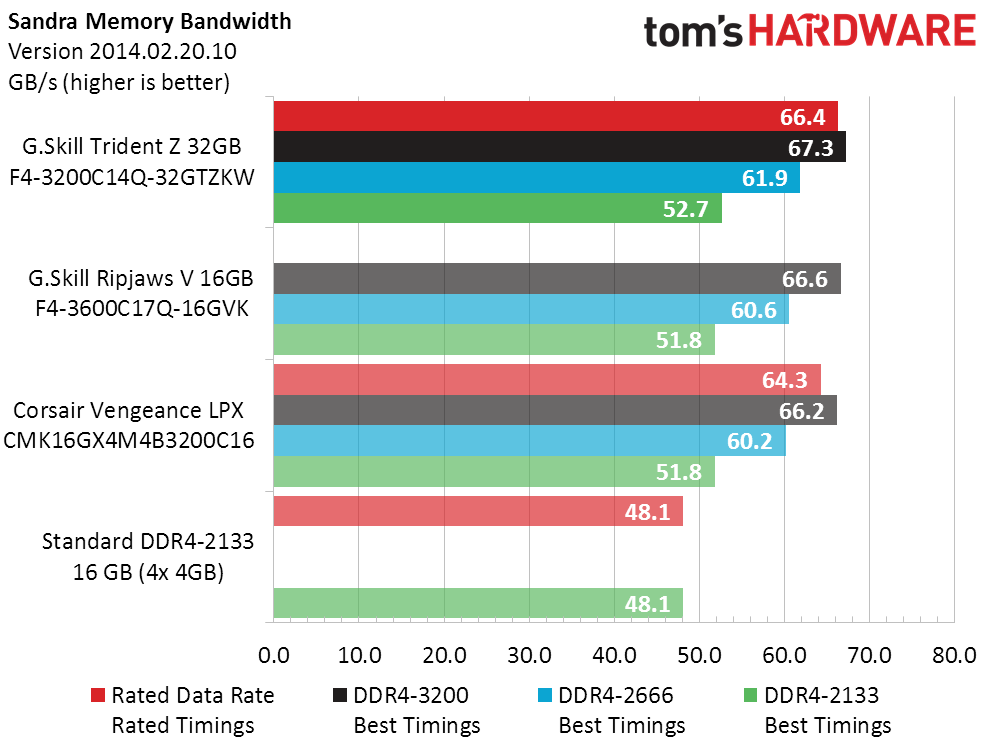
This is surely the chart G.Skill had in mind when requesting a Broadwell-E test in spite of overclocking problems. The 67 GB/s measurement in Sandra is simply incredible, even if it barely outpaces other DDR4-3200 modules.
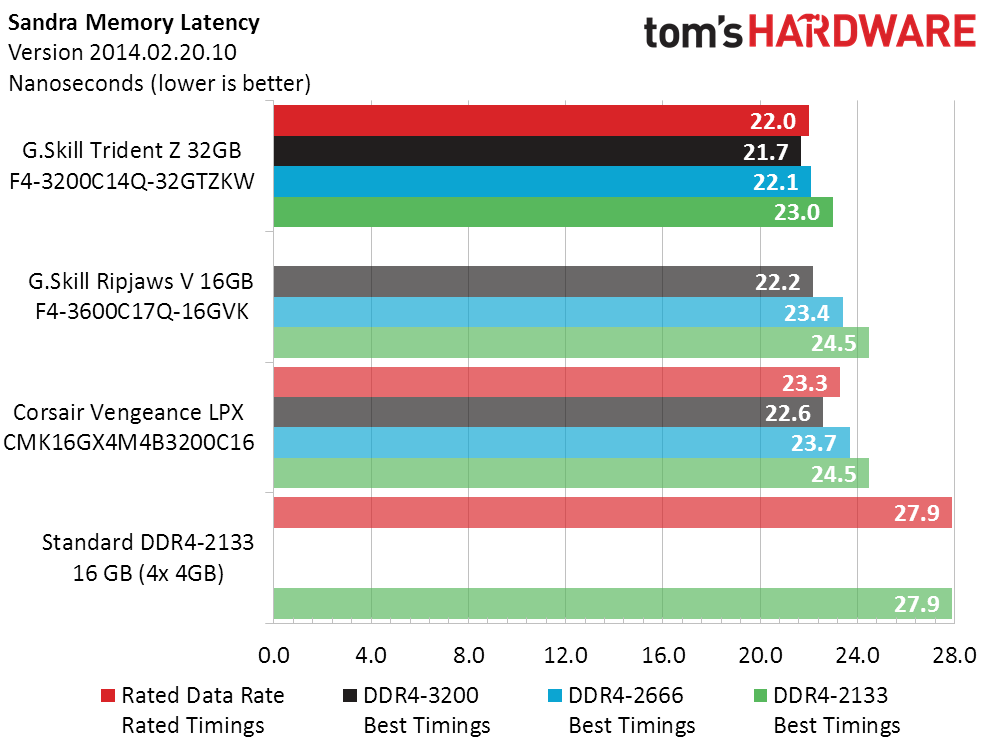
Perhaps G.Skill was also looking at Sandra Memory Latency when making its request? After all, it’s advantage here appears a little more pronounced compared to its bandwidth advantage.
Get Tom's Hardware's best news and in-depth reviews, straight to your inbox.
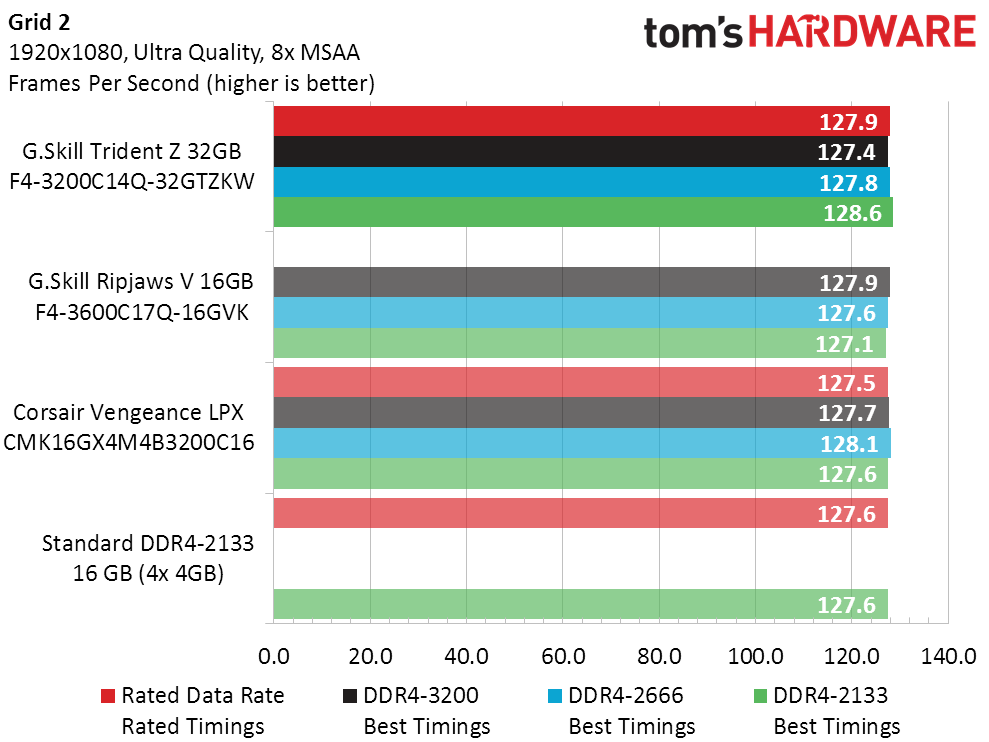
Grid 2 is typically “bound” by memory first, followed by CPU performance, then graphics. We could have showed a big performance gain by dropping the settings to “High” and eliminating AA, but would any real gamer do this when 120 FPS is good enough even for running shutter glasses on a 120 Hz screen? By putting more stress on the GPU, our search for settings an actual gamer might use eliminates the big performance spread.
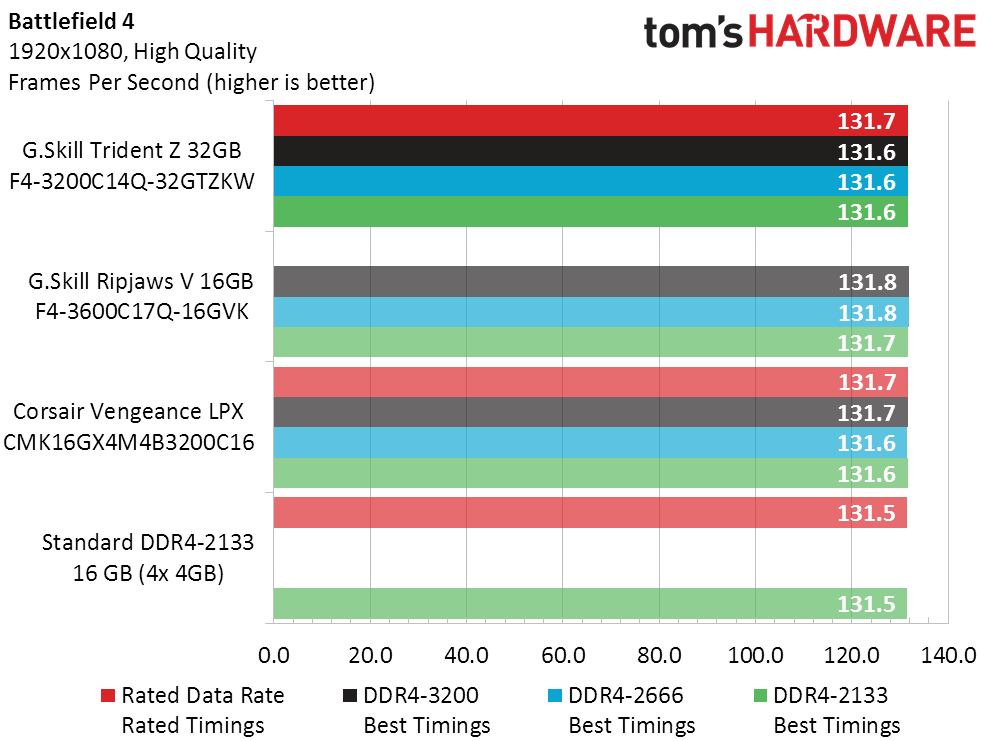
Battlefield 4 appears to indicate a performance advantage for faster system RAM, but is a tenth of a frame per second really worth anything during actual game play?
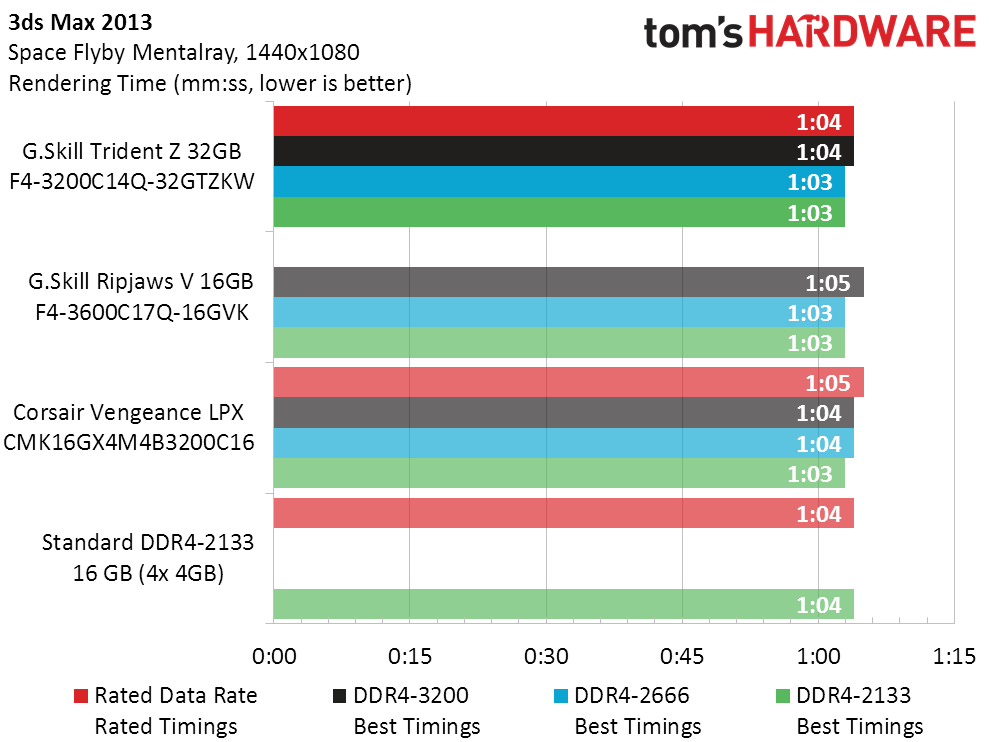
Timed applications typically have a one second “rounding error,” where consecutive tests show a result that’s either rounded up or down. Like flipping a coin, it never really comes out even. That means the 1:03 times we see for “faster” RAM at slower data rates are only usefully compared to the 1:05 results at higher data rates, and indicate that timing optimization is probably a better goal than bandwidth-chasing when seeking minuscule gains in this particular application.
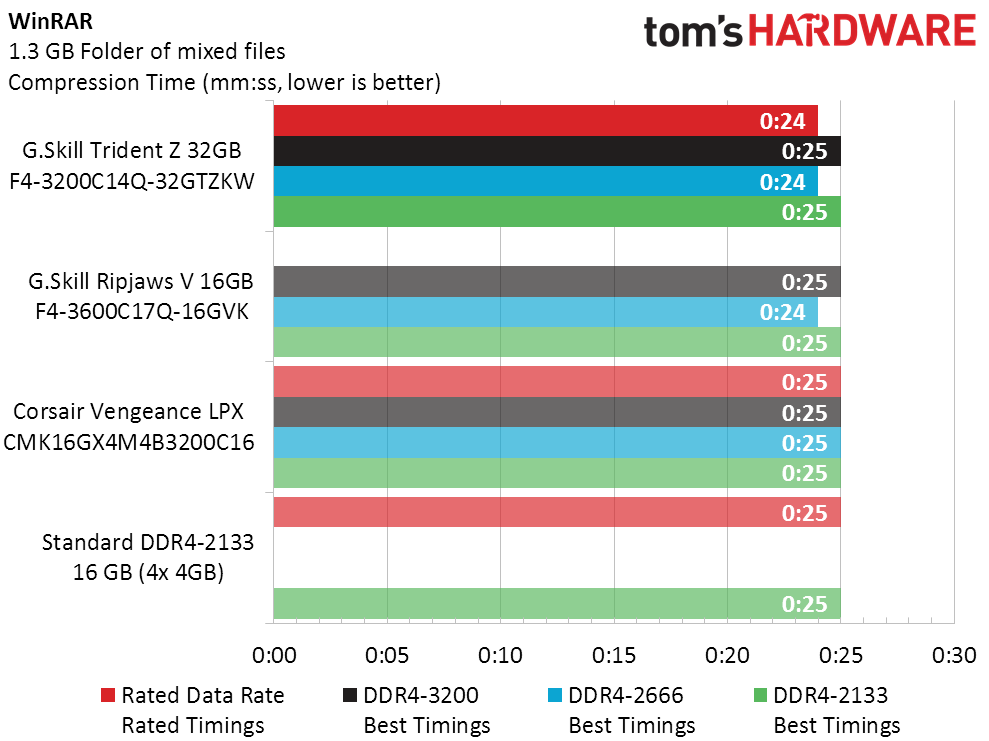
WinRAR presents the same evaluation conundrum as 3ds Max. In order to find noteworthy performance gains, we’d have to be moving up from a much slower memory standard.
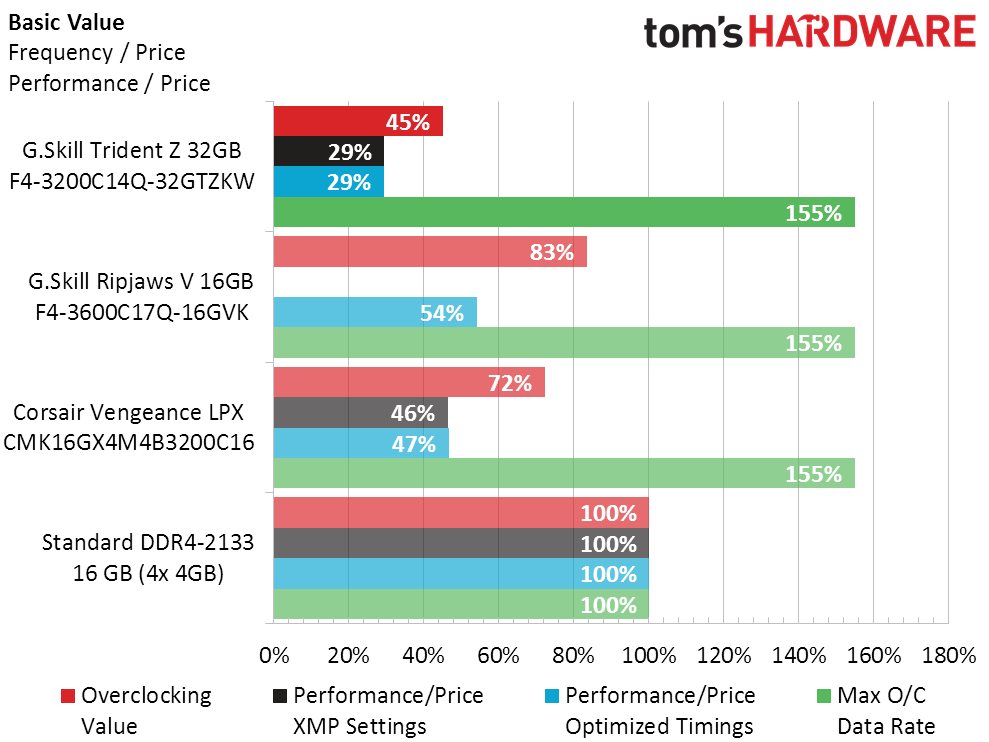
Using a $70 4x 4GB DDR4-2133 industry-standard kit as the baseline, we see among other things that faster memory (Ripjaws V and Vengeance LPX) costs more, and that higher capacity memory costs still more. A chart that compares these bang-for-the-buck scores to capacity is thus appropriate.
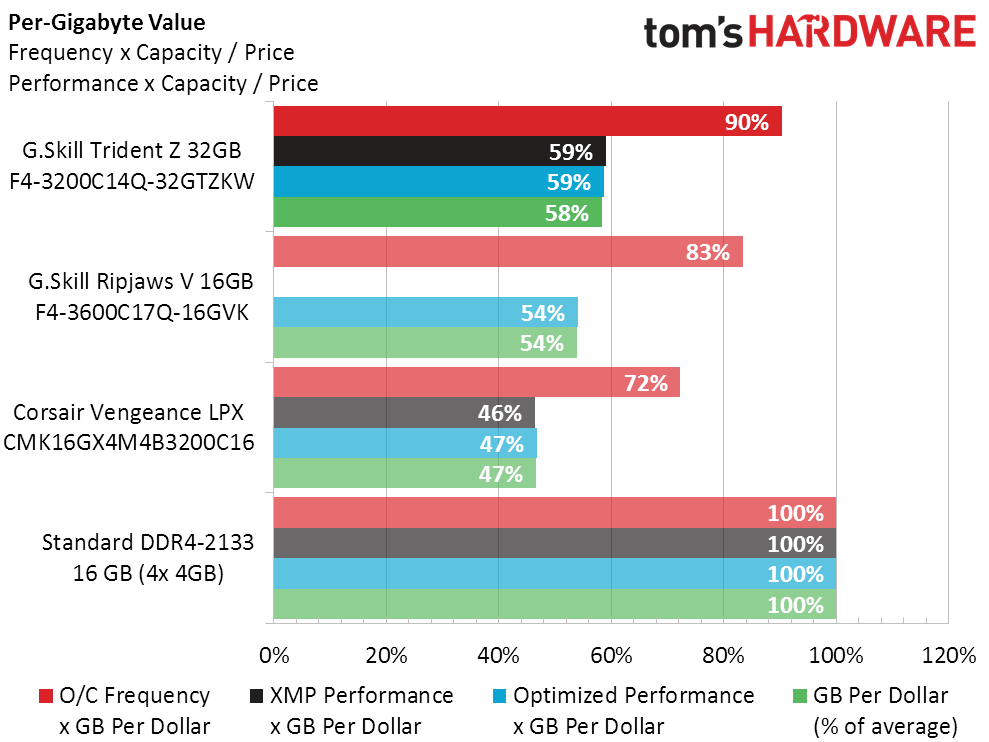
Our final chart clearly indicates that anyone who’s scrambling for that last bit of performance must also be willing to make a value sacrifice. It also shows that once a buyer is prepared to make that value sacrifice to simply get ahead of value RAM, a 32GB kit offers better capacity-per-dollar than a 16GB kit.
Lacking any comparable 32GB quad-channel kits, what can we say of G.Skill’s Trident Z F4-3200C14Q-32GTZ(KW)? The fact that it breached CAS 8 at DDR4-2133 is certainly noteworthy, and its rated CAS 14 at DDR4-3200 sets the baseline for future quad-channel memory testing. And so we’ll give it our baseline award while continuing our hopes for a future kit to win an even greater honor.
MORE: Best Memory
MORE: DDR DRAM FAQs And Troubleshooting Guide
MORE: All Memory Content
Follow us on Facebook, Google+, RSS, Twitter and YouTube.
-
Crashman Reply
You don't need to run it in quad-channel mode, and you'll probably get better overclocking by putting all four modules on a dual-channel board.18462548 said:Hmm, for double and quad channels do we need a MB that supports that?
-
joex444 I'm guessing the author's previous knowledge about games which are memory bound are coming from dual channel platforms with memory bandwidths in the 30GB/s range. This would clearly explain why, once moving to Broadwell-E with 60+GB/s, there's no evidence of a memory bound game.Reply
Looking at the bandwidth over the other DDR4-3200 kit, it's a 1.7% bump and a 4.0% drop in latency. Looking at WinRAR with a 25 second average runtime and the ability to measure to within 1 second, that's 1 part in 25: 4%. There was no point in running that benchmark since you need at least a 4% performance difference to pick up any hint of a performance difference and the synthetics show a 1.7-4% difference meaning we should expect real-world improvement to be somewhere in between as nothing is either fully bandwidth bound nor fully latency bound.
The second to last chart is an absolute disgrace comparing different size memory kits with absolute prices then coming to the startling conclusion that 32GB costs much more than 16GB. This is like complaining a 4TB drive at $120 costs more than a 1TB drive at $50, ignoring the fact that four 1TB drives would be $200. -
Crashman Reply
First of all, you downvoted me for stating the facts that a quad-DIMM kit will also run on a dual-channel board, and overclock better?18463370 said:I'm guessing the author's previous knowledge about games which are memory bound are coming from dual channel platforms with memory bandwidths in the 30GB/s range. This would clearly explain why, once moving to Broadwell-E with 60+GB/s, there's no evidence of a memory bound game.
Looking at the bandwidth over the other DDR4-3200 kit, it's a 1.7% bump and a 4.0% drop in latency. Looking at WinRAR with a 25 second average runtime and the ability to measure to within 1 second, that's 1 part in 25: 4%. There was no point in running that benchmark since you need at least a 4% performance difference to pick up any hint of a performance difference and the synthetics show a 1.7-4% difference meaning we should expect real-world improvement to be somewhere in between as nothing is either fully bandwidth bound nor fully latency bound.
The second to last chart is an absolute disgrace comparing different size memory kits with absolute prices then coming to the startling conclusion that 32GB costs much more than 16GB. This is like complaining a 4TB drive at $120 costs more than a 1TB drive at $50, ignoring the fact that four 1TB drives would be $200.
The second-to-last chart only gives readers a frame of reference for the last chart so that those who don't like doing math in their heads can still see what's going on. That's hardly as egregious as downvoting a correct answer :D
-
Nintendork So unless we ran the Bristol Ridge APU, even DDR4 2133 CL8 offers absolutely nothing to a el cheapo ram without head spreader gizmos.Reply -
AciMars Totally wrong game benchmark, Grid game has NO EFFECT using faster ram. Use GTA V BENCHMARK..Reply
